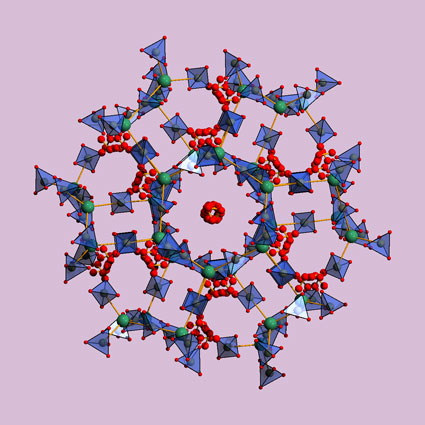- Home
- News
- General News
- A hydrogen reservoir...
A hydrogen reservoir made of … mostly hydrogen
03-10-2011
Crystalline hydrides, made of hydrogen and light elements such as boron, contain huge quantities of hydrogen but do not release it easily, due to their strong chemical bonds. Scientists have now, for the first time, succeeded in crystallising a highly porous hydride that can take up even more gas and release this additional amount when needed, like a reservoir or a gas bottle. The results are published as an Early View VIP paper in Angewandte Chemie, and highlighted by a inside cover page in the November 2011 issue.
Share
The international team included researchers from the universities of Louvain-la-Neuve (Belgium), Aarhus (Denmark) and Geneva (Switzerland), along with the European Synchrotron Radiation Facility (ESRF) in Grenoble (France). The main author is Yaroslav Filinchuk from the Université Catholique de Louvain, University of Aarhus and ESRF.
Hydrogen is the most promising candidate fuel for future clean cars and trucks. The main reason it is not widely used today is the lack of affordable and safe mobile storage systems. Research into storage systems is focusing on two classes of materials: complex hydrides containing light elements such as boron, nitrogen or aluminium (borohydrides, amides, alanates); and porous materials, so-called metal-organic frameworks (MOFs). Unfortunately, whilst hydrides store large amounts of hydrogen, they release it only at relatively high temperatures. On the other hand, MOFs store and release molecular hydrogen easily, but only at cryogenic temperatures. The two groups of materials are made of completely different building blocks, representing two diverse fields of chemistry.
The new substance, obtained by Bo Richter from the University of Aarhus, combines the properties of both: it is highly porous like a MOF but entirely made of a hydride. This new form of magnesium borohydride (γ-Mg(BH4)2) stores 15 weight percent of hydrogen in the bulk material, representing an energy density equivalent to 50% of that of diesel fuel. In the pores, the material has the capability to store another 3 weight percents of H2, at low temperatures, which alone represent 5 times the energy density of a modern lithium-ion battery.
As the material is crystalline, the researchers could study its gas uptake and release as well as its pressure- and temperature-induced transformations by X-ray diffraction. Most of these experiments were carried out at BM01, the Swiss-Norwegian Beam Lines at the ESRF. The scientists discovered that about one third of the new material is empty and this space can store various guest molecules, including hydrogen, nitrogen and even small organic molecules. It holds these gases at higher temperatures than most other porous solids. The nature of interaction between the "guest" gas molecules and the "host" nanoporous framework was also revealed by X-ray diffraction.
Information on the structure and properties of the new material allowed the researchers to infer the nature of the chemical bonds and building principles in metal borohydrides. This research opens a door, via combining the BH4 anions with more complex ligands, to novel hybrid materials which could be highly selective gas storage and/or separation systems.
 |
|
Hydrogen gas molecules (red spheres) stored within the crystalline magnesium borohydride structure (Mg green, BH4 blue). |
“This work opens a new field of chemistry, merging MOFs and hydrides. My vision is to design ‘hybrid hydride materials’ with improved gas storage properties and controlled stability. This would be a revolution, not only for tomorrow’s cars.” says Yaroslav Filinchuk.
Principal publication and authors
Porous and Dense Magnesium Borohydride Frameworks: Synthesis, Stability, and Reversible Absorption of Guest Species, Y. Filinchuk, (a,b,c), B. Richter, (b), T.R. Jensen, (b), V. Dmitriev, (c), D. Chernyshov, (c), H. Hagemann, (d), Angew. Chem. Int. Ed. (2011); DOI: 10.1002/anie.201100675.
(a) Université Catholique de Louvain (Belgium)
(b) Aarhus University (Denmark)
(c) SNBL at ESRF (France)
(d) University of Geneva (Switzerland)



